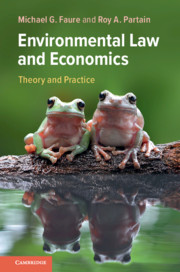Book contents
- Environmental Law and Economics
- Environmental Law and Economics
- Copyright page
- Contents
- Preface
- Acknowledgements
- Abbreviations
- 1 Introduction
- 2 Environmental Harm and Efficiency
- 3 Property Rights Approach to Environmental Law
- 4 Environmental Standard Setting
- 5 Principles of Environmental Law and Environmental Economics
- 6 Pricing Environmental Harm
- 7 Market-Based Instruments
- 8 Liability Rules
- 9 Environmental Regulation
- 10 Environmental Crime
- 11 Insurance for Environmental Damage
- 12 Compensation for Environmental Damage
- 13 Environmental Federalism
- 14 The Role of Environmental Law in Developing Countries
- 15 Epilogue
- References
- Index
2 - Environmental Harm and Efficiency
Published online by Cambridge University Press: 13 September 2019
- Environmental Law and Economics
- Environmental Law and Economics
- Copyright page
- Contents
- Preface
- Acknowledgements
- Abbreviations
- 1 Introduction
- 2 Environmental Harm and Efficiency
- 3 Property Rights Approach to Environmental Law
- 4 Environmental Standard Setting
- 5 Principles of Environmental Law and Environmental Economics
- 6 Pricing Environmental Harm
- 7 Market-Based Instruments
- 8 Liability Rules
- 9 Environmental Regulation
- 10 Environmental Crime
- 11 Insurance for Environmental Damage
- 12 Compensation for Environmental Damage
- 13 Environmental Federalism
- 14 The Role of Environmental Law in Developing Countries
- 15 Epilogue
- References
- Index
Summary
This book covers the fundamental principles of environmental law; how they can be reframed from a rational actor perspective. The tools of law and economics can be brought to bear on policy questions within environmental law. The approach taken in this book is to build on the existing consensus in international environmental law and to provide it with new analytical tools to improve the design of legal rules and to enable prospective modelling of the effects of rules in pre-implementation stages of evaluation and deliberation. The Pigouvian idea of environmental injuries as economic externalities. The core idea of Pigou’s model is that manufacturing costs that are excluded from the decision-making process will inherently not be reflected in the decision making of producers, and thus, manufacturing costs will be incorrectly perceived as lower than they actually are. The key is to ensure better decision making and to prevent environmental injuries by ‘internalising’ the cost externalities. Rational actors, forced to bear the costs of the injuries resulting from their production activities, will set optimal levels of production inclusive of minimising the costs of pollution injuries via reducing the incidence of those pollution injuries
Keywords
- Type
- Chapter
- Information
- Environmental Law and EconomicsTheory and Practice, pp. 10 - 36Publisher: Cambridge University PressPrint publication year: 2019



